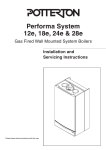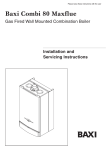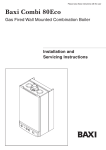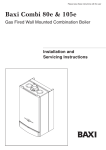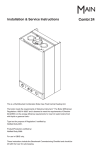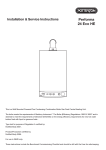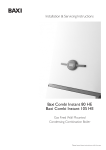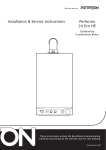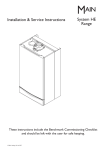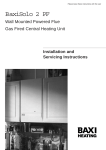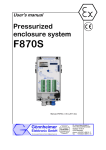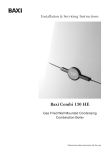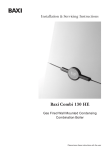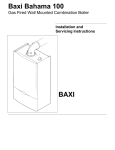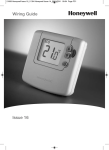Download Baxi Combi 80 Maxflue Technical data
Transcript
Please leave these instructions with the user Baxi Combi 80 Maxflue Gas Fired Wall Mounted Combination Boiler Installation and Servicing Instructions Natural Gas Baxi Combi 80 Maxflue G.C.No 47 075 07 Baxi UK Limited is one of the leading manufacturers of domestic heating products in the UK. Our first priority is to give a high quality service to our customers. Quality is designed into every Baxi product - products which fulfil the demands and needs of customers, offering choice, efficiency and reliability. To keep ahead of changing trends, we have made a commitment to develop new ideas using the latest technology - with the aim of continuing to make the products that customers want to buy. Everyone who works at Baxi has a commitment to quality because we know that satisfied customers The boiler meets the requirements of Statutory Instrument “ The Boiler (Efficiency) Regulations 1993 No 3083” and is deemed to meet the requirements of Directive 92/42/EEC on the energy efficiency requirements for new hot water boilers fired with liquid or gaseous fuels:Type test for purpose of Regulation 5 certified by: Notified Body 0051. mean continued success. Product/Production certified by: Notified Body 0051. We hope you get a satisfactory service from Baxi. If not, please let us know. Baxi is a BS-EN ISO 9001 Accredited Company 2 For GB/IE only. Contents Section Page 1.0 Introduction 4 2.0 General Layout 5 3.0 Appliance Operation 6 4.0 Technical Data 7 5.0 Dimensions and Fixings 8 6.0 System Details 9 7.0 Site Requirements 12 8.0 Installation 18 9.0 Commissioning the Boiler 23 10.0 Completion 25 11.0 Servicing the Boiler 26 12.0 Changing Components 28 13.0 Illustrated Wiring Diagram 37 14.0 Fault Finding 38 15.0 Short Parts List 43 3 1.0 Introduction Baxi UK Limited declare that no substances harmful to health are contained in the appliance or used during appliance manufacture. Case Front Panel 1.1 Description 1. The Baxi Combi 80 Maxflue is a fully automatic gas fired wall mounted combination boiler. It is room sealed and fan assisted, and will serve central heating and mains fed domestic hot water. 2. The boiler is set to give a maximum output of 24.0 kW for hot water and central heating. 3. It is designed for use on Natural Gas (G20) and can be converted to use Propane or Butane. 4. The boiler is suitable for use only on fully pumped sealed heating systems. Priority is given to domestic hot water. 5. The boiler data badge gives details of the model, serial number and Gas Council number and is situated on the control box. It is visible when the case front panel is removed (Fig. 1). Control Box 6. The boiler is intended for use with an 80mm diameter twin flue system. The system must be installed in conjunction with a single roof terminal or two separate flue and air terminals. Fig. 1 Data Badge 7. Separate terminals do not have to be on the same wall but must not be on opposite walls of the dwelling. 8. The separate terminals allow greater flexibility when siting the boiler - see Sections 7.8 to 7.13 of Site Requirements for full details of available flue components, maximum lengths etc. 9. The boiler is intended to be installed in residential / commercial / light industrial E.M.C. environments on a governed meter supply only. 10. All systems must be thoroughly flushed and treated with inhibitor (see section 6.2). NOTE: This appliance must be installed in accordance with the manufacturer’s instructions and the regulations in force. Read the instructions fully before installing or using the appliance. “Benchmark” Log Book As part of the industry-wide “Benchmark” initiative all Baxi boilers now include an Installation, Commissioning and Service Record Log Book. Please read the Log Book carefully and complete all sections relevant to the appliance and installation. These include sections on the type of controls employed, flushing the system, burner operating pressure etc. The details of the Log Book will be required in the event of any warranty work. Also, there is a section to be completed at each subsequent regular service visit. The Log Book must be left with the user. 4 1.2 Installation 1. The appliance is suitable for installation only in G.B. and I.E. and should be installed in accordance with the rules in force. For Ireland install in accordance with I.S.813 “INSTALLATION OF GAS APPLIANCES”. The installation must be carried out by a CORGI Registered Installer or other competent person and be in accordance with the relevant requirements of GAS SAFETY (Installation and Use) REGULATIONS, the BUILDING REGULATIONS (Scotland) (Consolidation), the LOCAL BUILDING REGULATIONS, the CURRENT I.E.E. WIRING REGULATIONS and the bye laws of the Local Water Undertaking. Where no specific instructions are given, reference should be made to the relevant BRITISH STANDARD CODES OF PRACTICE. 1.3 Optional Extras Various control accessories, LPG conversion kits etc. are available as optional extras. These are detailed in a separate publication. 2.0 General Layout 2.1 Layout 1. Air Pressure Switch 2. Expansion Vessel 3. Burner Manifold 4. Automatic Air Vent 5. DHW Plate Heat Exchanger 6. Circulation Pump 7. Drain Off Point 8. Pressure Relief Valve 9. Position For Optional Integral Timer 10. Central Heating System Pressure Gauge 15 11. PCB 14 12. Control Box 13. 3-Way Valve Assembly 14. Flame Sensing Electrode 15. Spark Electrode 16. Burner 17. Primary Heat Exchanger 18. Fan Assembly 19. On/Off/Reset Selector Switch 20. Central Heating Temperature Control 21. Hot Water Temperature Control 22. Flame Failure 23. Safety Thermostat 24. Fault on Fan or Flue 25. Fault on Pump or Low System Pressure 26. Fault on Hot Water Sensor 27. Fault on Central Heating Sensor 28. Power On 29. Hot Water Mode 30. Central Heating / Hot Water Mode 31. Burner On 18 17 1 16 2 3 4 13 5 6 7 8 11 10 9 22 23 24 25 26 27 30° 40° 50° 60° 70° 80° When neons 22 to 27 are constantly illuminated, they indicate the temperature of the central heating water. 28 29 30 31 30° 40° 50° 60° 70° 80° 2 1 3 4 0 12 bar 19 20 21 10 9 5 3.0 Appliance Operation 1 Central Heating Circuit NOTE: All delay timers mentioned in 3.1 and 3.2 are overridden by domestic hot water demand. 3.1 2 3 4 7 26 5 6 25 24 23 9 27 21 11 17 10 16 19 15 14 13 3. When the flow temperature exceeds the setting temperature, a 3 minute delay occurs before the burner relights automatically (anti-cycling). The pump continues to run during this period. 4. When the demand is satisfied the burner is extinguished and the pump continues to run for a period of 3 minutes (Pump Overrun). 20 18 1. With a demand for heating, the pump circulates water through the primary circuit. At a flow rate of approximately 125 l/hr the central heating flow switch operates, initiating the ignition sequence. 2. The main burner ignites at low rate, then the gas valve controls the gas rate to maintain the heating temperature measured by the thermostat sensor. 8 22 Central Heating Mode (Fig. 2) 12 Fig. 2 3.2 Key 1 2 3 4 5 6 7 8 9 10 11 12 13 Primary Heat Exchanger Burner Ignition Electrode Flame Sensing Electrode Gas Valve Pump Automatic Air Vent Plate Heat Exchanger Flow Sensor with Filter Pressure Relief Valve Boiler Drain Point Heating Return Cold Water Inlet On/Off Valve and Filter 14 15 16 17 18 19 20 21 22 23 24 25 26 27 Gas Inlet Domestic Hot Water Outlet Heating Flow Pressure Gauge Hydraulic Differential Pressure Sensor Microswitch Automatic By-Pass Hydraulic Differential Pressure Sensor Diverter Valve Assembly Domestic Hot Water Flow Priority Assembly Domestic Hot Water Flow Priority Microswitch Overheat Thermostat Central Heating NTC Sensor Expansion Vessel Domestic Hot Water NTC Sensor 1. Priority is given to the domestic hot water supply. A demand at a tap or shower will override any central heating requirement. 2. The flow of water will operate the DHW flow switch which causes the 3 way valve to change position. This will allow the pump to circulate the primary water through the DHW plate heat exchanger. 3. The burner will light automatically and the temperature of the domestic hot water is controlled by the thermostat sensor. 4. When the domestic hot water demand ceases the burner will extinguish and the diverter valve will remain in the domestic hot water mode, unless there is a demand for central heating. 1 Domestic Hot Water Circuit 2 3 4 7 26 5 IMPORTANT: When the selector switch is in the ‘0’ (Off) position the electrical supply to the boiler is isolated. The boiler will not operate and the integral timer (if fitted) will require resetting once the selector switch is set to either the DHW position or CH position. 6 3.3 25 24 8 23 9 22 21 17 11 27 10 20 16 Fig. 3 6 18 19 14 13 Frost Protection Mode 1. The frost protection mode is integral to the appliance and functions only with the selector switch (see Section 2.1) in the domestic hot water and central heating position. If the system temperature falls below 5° C then the boiler will fire on its minimum setting until a flow temperature of 30° C is reached. Further protection can be incorporated by using a system frost thermostat. 3.4 15 Domestic Hot Water Mode (Fig. 3) Pump Protection 12 1. With the selector switch (see Section 2.1) in either the central heating or central heating and hot water position the pump will automatically operate for 1 minute in every 24 hours to prevent sticking 4.0 Technical Data 4.1 Appliance Type C12 C32 C52 Appliance Category CAT II 2H 3+ Heat Input C/H & DHW (Gross) kW 26.3 Max Btu/h 89,739 Max Heat Output Max Min kW 24.0 9.3 Btu/h 81,891 31,730 Max Gas Rate (Natural Gas) (After 10 Mins) m3/h 2.78 ft3/h 98.12 Burner Pressure (Natural Gas) Max Rate Min Rate mbar 10.6 ± 0.5 1.9 ± 0.2 in wg 4.24 ± 0.2 0.76 ± 0.2 Inlet Pressure (Natural Gas) mbar 20 in wg 8 Burner Injector (Natural Gas) 15 x 1.18mm Diameter Electrical Supply 230V~ 50Hz (Appliance must be connected to an earthed supply) Power Consumption 170W External Fuse Rating 3A Internal Fuse Rating Fuse 2A Fast Blow to BS 4265 NOx Class 3 Flue Terminal Dimensions Diameter Projection Connections Gas Supply Central Heating Flow Central Heating Return Cold Water Mains Inlet DHW Flow Pressure Relief Discharge Outercase Dimensions Casing Height Overall Height Inc Flue Elbow Casing Width Casing Depth Clearances Both Sides Above Casing Below Casing Front Front - Combi 80 Maxflue DHW Circuit Pressures Max Operating Min Operating 80mm 80mm 780mm - 980mm 450mm 345mm l/min 13.7 DHW Flow Rate @ 35o C Rise 9.8 Min Working DHW Flow Rate 2.5 See graph below Expansion Vessel - (For Central Heating only. Integral with appliance) bar Min Pre-charge Pressure 0.5 litre Max Capacity of CH System Primary Water Content of Boiler (unpressurised) kg 47.5 2.5 39.5 125 1.0 Temperatures C.H. Flow Temp (adjustable) 35°C to 85°C max (± 5°C) Central Heating Primary Circuit Pressures bar 3 2.5 0.5 1-2 Safety Discharge Max Operating Min Operating Recommend Operating 0.9 Flow Rates DHW Flow Rate @ 30o C Rise Pump Available Head 5 mm Min 200 mm Min 200 mm Min 450 mm Min (For Servicing) 5 mm Min (In Operation) Weights Packaged Boiler Carton Packaged Flue Kit Installation Lift Weight 8 0.2 Min Operating Pressure at 9.8 l/min copper tails 22mm 22mm 22mm 15mm 15mm 15mm - bar D.H.W. Flow Temp (adjustable) 35°C to 65°C max (± 5°C) dependent upon flow rate Electrical Protection IPX5D SEDBUK Declaration For Combi 80 Maxflue Pump - Available Head 4 The seasonal efficiency (SEDBUK) is 78.5 % 3.5 This value is used in the UK Government’s Standard 3 Assessment Procedure (SAP) for energy rating of dwellings. certified by 0051. 2.5 Metre wg The test data from which it has been calculated have been 2 1.5 LPG Gases Propane - G31 and Butane - G30 1 Burner Injector 15 x 0.69 0.5 Burner Pressure Max Rate Min Rate Propane mbar 35.8 6.2 in wg 14.3 2.5 Butane mbar 28.0 4.7 in wg 11.2 1.9 Inlet Pressures Propane mbar 37 in wg 14.8 0 l/h 0 200 400 600 800 1000 1200 Butane 30 12 7 5.0 Dimensions and Fixings Dimensions A 780mm A B 345mm C 450mm C B Tap Rail 65 mm Heating Flow (22mm) 8 65 mm Domestic Hot Water Outlet (15mm) 65 mm Gas Inlet (22mm) 65 mm Cold Water Inlet (15mm) 65 mm Heating Return (22mm) Pressure Relief Valve (15mm) 6.0 System Details 6.1 Information 1. The Baxi Combi 80 Maxflue Combination Boiler is a ‘Water Bylaws Scheme - Approved Product’. To comply with the Water Bylaws your attention is drawn to the following installation requirements and notes (IRN). a) IRN 001 - See text of entry for installation requirements and notes. b) IRN 302 - Bylaw 14. 2. Reference to the WRC publications, ‘Water fittings and materials directory’ and ‘Water supply bylaws guide’ give full details of bylaws and the IRNs. 6.2 Central Heating Circuit 1. The appliance is suitable for fully pumped SEALED SYSTEMS ONLY. Treatment of Water Circulating Systems • All recirculatory water systems will be subject to corrosion unless an appropriate water treatment is applied. This means that the efficiency of the system will deteriorate as corrosion sludge accumulates within the system, risking damage to pump and valves, boiler noise and circulation problems. • For optimum performance after installation this boiler and its associated central heating system must be flushed in accordance with the guidelines given in BS 7593 “Treatment of water in domestic hot water central heating systems”. • This must involve the use of a proprietary cleanser, such as BetzDearborn Sentinel X300 or X400, or Fernox Superfloc. Full instructions are supplied with the products, but for immediate information please contact BetzDearborn (0151 420 9563) or Fernox (01799 550 811) directly. • For long term protection against corrosion and scale, after flushing it is recommended that an inhibitor such as BetzDearborn Sentinel X100, or Fernox MB-1 or Copal is dosed in accordance with the guidelines given in BS 7593. Failure to flush and add inhibitor to the system may invalidate the appliance warranty. • It is important to check the inhibitor concentration after installation, system modification and at every service in accordance with the manufacturer’s instructions. (Test kits are available from inhibitor stockists.) • For information or advice regarding any of the above contact Baxi Technical Enquires. 6.3 Bypass 1. The boiler is fitted with an automatic integral bypass. 6.4 System Control 1. The boiler is designed for use in a heating system that incorporates external controls, i.e. a minimum of a timer device. 2. Suitable timer kits are available as optional extras. 3. For optimum operating conditions and maximum economy the fitting of a programmable room thermostat, such as the Baxi Combi Controller, is recommended. 9 6.0 System Details 6.5 System Filling and Pressurising 1. A filling point connection on the central heating return pipework must be provided to facilitate initial filling and pressurising and also any subsequent water loss replacement/refilling. Stop Valve Double Check Valve DHW Mains Inlet Fig. 4 Stop Valve Temporary Hose 2. There are connection points on the mains cold water inlet and central heating return isolating taps (Fig. 4a) to which the optional filling loop kit (Part No. 248221) can be assembled. CH Return 3. The filling method adopted must be in accordance with the Water Supply (Water Fittings) regulations and the Water Bylaws (Scotland). 4. Your attention is drawn to: Paragraph 24 of Schedule 2 Section 8 of the publication Water Regulations Guide which gives recommendations and guidance on approved methods for filling sealed systems. 5. The sealed primary circuits may be filled or replenished by means of a temporary connection between the primary circuit and a supply pipe provided the arrangement in accordance with Diagram R24.2a of the Water Regulations Guide. 6. The temporary hose must be completely removed at both ends after use. Fig. 4a 6.6 Expansion Vessel (Central Heating only) 1. The appliance expansion vessel is pre-charged to 0.5 bar. Therefore, the minimum cold fill pressure is 0.5 bar. The vessel is suitable for correct operation for system capacities up to 125 litres. For greater system capacities an additional expansion vessel must be fitted - refer to BS 7074 Pt 1. Filling Loop 6.7 Fig. 5 Pressure Relief Valve Discharge Pipe Pressure Relief Valve (Fig. 5) 1. The pressure relief valve is set at 3 bar, therefore all pipework, fittings, etc. should be suitable for pressures in excess of 3 bar. 2. The pressure relief discharge pipe should be not less than 15mm dia, run continuously downward, and discharge outside the building, preferably over a drain. It should be routed in such a manner that no hazard occurs to occupants or causes damage to wiring or electrical components. The end of the pipe should terminate facing down and towards the wall. 3. The discharge must not be above a window, entrance or other public access. Consideration must be given to the possibility that boiling water/steam could discharge from the pipe. 10 6.0 System Details Other Tap Outlets 6.8 Expansion Vessel Boiler Stop Tap Fig. 6 1. All DHW circuits, connections, fittings, etc. should be fully in accordance with relevant standards, the Water Supply (water fittings) Regulations and the Water Bylaws (Scotland). 2. Your attention is drawn to: Schedule 2, Section 6 of the publication Water Regulations Guide which relates to backflow prevention. Check Valve Pressure Reducer Valve Domestic Hot Water Circuit (Fig. 6) To Hot Taps 3. A single check valve must be fitted as shown in Fig. 6 to prevent backflow to the supply pipe and to ensure the efficient operation of the expansion vessel which is required to accommodate the thermal expansion of the water. 4. When the domestic water system includes any device which prevents water expanding back towards the supply (check valve, loose jumpered stopcock, water meter, water treatment device) then an expansion vessel must be fitted (eg. Zilmet 160ml, R1/2 15bar). 5. If the hot water expansion is not provided for, then high pressures can develop which may result in damage to fittings and devices on the system. 6. The boiler’s maximum working mains pressure is 8 bar, therefore all pipework, connections, fittings, etc. should be suitable for pressures in excess of 8 bar. A pressure reducing valve must be fitted for pressures in excess of 8 bar. The manufacturer of any outlet fittings, such as a shower valve, may require a lower maximum pressure. The pressure reduction must take account of all fittings connected to the DHW system. 6.9 Showers 1. If a shower control is supplied from the appliance it should be of the thermostatic or pressure balanced type. Thermostatic type shower valves provide the best comfort and guard against water at too high a temperature. Existing controls may not be suitable - refer to the shower valve manufacturer. 6.10 Hard Water Areas 1. If the area of the installation is recognised as a HARD WATER AREA then a suitable device should be fitted to treat the mains water supply to the boiler. 11 7.0 Site Requirements 450mm 5mm Min 5mm Min 7.1 5mm both sides recommended for ease of installation and service. 200mm Min 1. The installation must be carried out by a CORGI Registered Installer or other registered competent person and be in accordance with the relevant requirements of the current GAS SAFETY (Installation and Use) REGULATIONS, the BUILDING REGULATIONS (Scotland)(Consolidation), the LOCAL BUILDING REGULATIONS, the current I.E.E. WIRING REGULATIONS and the bye laws of the LOCAL WATER UNDERTAKING. Where no specific instruction is given reference should be made to the relevant BRITISH STANDARD CODES OF PRACTICE. For Ireland install in accordance with IS 813 “INSTALLATION OF GAS APPLIANCES”. 7.2 780mm Information B.S. Codes of Practice Standard Scope BS 6891 BS 5546 Gas Installation. Installation of hot water supplies for domestic purposes. Forced circulation hot water systems. Installation of gas fired hot water boilers. Flues. Ventilation. Expansion vessels and ancillary equipment for sealed water systems. Treatment of water in domestic hot water central heating systems. BS 5449 Part 1 BS 6798 BS 5440 Part 1 BS 5440 Part 2 BS 7074 BS 7593 200mm Min Fig. 7 WARNING - The addition of anything that may interfere with the normal operation of the appliance without the express written permission of Baxi UK Limited could invalidate the appliance warranty and infringe the GAS SAFETY (Installation and Use) REGULATIONS. 7.3 Clearances (Figs. 7 & 8) 1. A flat vertical area is required for the installation of the boiler. 2. These dimensions include the necessary clearances around the boiler for case removal, spanner access and air movement. Additional clearances may be required for the passage of pipes around local obstructions such as joists running parallel to the front face of the boiler. 450mm Min For Servicing Purposes 7.4 Ventilation of Compartments 1. Where the appliance is installed in a cupboard or compartment, no air vents are required as the appliance runs sufficiently cool. 2. The minimum clearances must be adhered to and the cupboard or compartment big enough to house only the boiler and any ancillary equipment. 5mm Min In Operation Fig. 8 12 7.0 Site Requirements 7.5 Location 1. The boiler may be fitted to any suitable internal or external wall. It is primarily intended for use with a twin flue system using separate horizontal terminals. It may also be fitted with a vertical twin flue system connected to a single vertical terminal. The terminal(s) must pass through an outside roof (vertical) or wall (separate horizontal), discharging to atmosphere in a position permitting satisfactory removal of combustion products and providing an adequate air supply. The boiler should be fitted within the building unless otherwise protected by a suitable enclosure i.e. garage or outhouse. (The boiler may be fitted inside a cupboard-see Section 7.4). Plan view of boiler showing acceptable terminal locations 2. If the boiler is sited in an unheated enclosure then it is recommended to leave the ON/OFF Selector Switch in the domestic hot water and central heating position to give frost protection. Fig. 9 3. If the boiler is fitted in a room containing a bath or shower reference must be made to the current I.E.E. WIRING REGULATIONS and BUILDING REGULATIONS. If the boiler is to be fitted into a building of timber frame construction then reference must be made to the current edition of Institute of Gas Engineers Publication IGE/UP/7 (Gas Installations in Timber Framed Housing). 4. Separate terminals may be located on the same or different walls as required, but they must not be on opposing walls. For example if one terminal is on a north facing wall the other terminal may be on the west, east or north wall but not the south (Fig. 9). 7.6 Gas Supply 1. The gas installation should be in accordance with BS6891. 2. The connection to the appliance is a 22mm copper tail located at the rear of the gas service cock (Fig. 10). 3. Ensure that the pipework from the meter to the appliance is of adequate size. Do not use pipes of a smaller diameter than the boiler gas connection (22mm). 7.7 Electrical Supply 1. External wiring must be correctly earthed, polarised and in accordance with current I.E.E. WIRING REGULATIONS. 2. The mains supply is 230V ~ 50Hz fused at 3A. Fig. 10 Gas Service Cock NOTE: The method of connection to the electricity supply must facilitate complete electrical isolation of the appliance. Connection may be via a fused double-pole isolator with a contact separation of at least 3mm in all poles and servicing the boiler and system controls only. 13 7.0 Site Requirements Air Terminal Appliance Position Input (kW) Above a Terminal Below a Terminal Horizontally to a Terminal Table 1 Separation in mm from another terminal Natural Draught Fanned Draught 0-7 7-14 14-32 over 32 300 600 1500 2000 300 300 300 300 0-7 7-14 14-32 over 32 300 300 300 600 300 300 300 300 0-7 7-14 14-32 over 32 300 400 600 600 300 300 300 300 7.8 Flue & Air Terminals 1. The flue terminal position must always be in accordance with the current edition of B.S. 5440 Part 1, and either Part J of the Building Regulations England and Wales or Part F of the Building Standards (Scotland) Regulations as appropriate. 2. The positioning of the air terminal (separate terminal systems only) is not as critical as that of the flue terminal except with respect to other flue terminals, including that of the appliance the air terminal is serving. Note: “Appliance Input” refers to any other appliance as well as the one served by the air terminal 3. When positioning the air terminal general reference should be made to BS 5440 Pt. 2. Specifically the air terminal must be separated from any other flue terminal by at least the dimensions given in Table 1. 4. The air terminal must draw directly from outside. It is not permissible to locate it in a loft space, compartment or similar even when there is adequate ventilation. 5. See Section 7.5 “Location” for details of which walls the terminals may be located on. Minimum clearances from the flue terminal are given in Fig. 11 and the accompanying table. L K B,C N G G D 6. If the flue terminal discharges onto a pathway or passageway, check that combustion products will not cause a nuisance. Ensure that any terminal will not obstruct any pathway or passageway. M J A A E F D H,I F G Likely flue positions requiring a flue terminal guard Fig. 11 Terminal Position with Minimum Distance (Fig. 11) A (mm) Directly below an openable window, air vent or any other ventilation opening. 300 B Below gutter, drain/soil pipe. 25 C Below eaves. 25 D Below a balcony/car port roof. 25 E From vertical drain pipes and soil pipes. 25 F From internal or external corners. 25 G Above adjacent ground or balcony level. 300 H From a surface facing a terminal. 600 I Facing a terminals. 1200 J From opening (door/window) in carport into dwelling. 1200 K Vertically from a terminal on the same wall. 1500 L Horizontally from a terminal on the same wall. 300 M Above an opening, air brick, opening window etc. 300 N Horizontally to an opening, air brick, opening window etc. 300 7. If a terminal is less than 2 metres above a balcony, above ground or above a flat roof to which people have access, then a suitable terminal guard must be provided. This also applies to the air terminal where provision of the guard will prevent damage or blockage, rather than the protection of persons from hot flue gases. 8. The terminals must be positioned such that they will not become obstructed by leaves, snow or similar and not be subject to rain entry. Terminal Assembly 300 min Top View Rear Flue Property Boundary Line 14 7.0 Site Requirements Condensate Collector 7.9 90° Male - Male Elbow Flue Connections 1. The flue duct adaptor, air duct adaptor, 90° male - male elbow and condensate collector are supplied in a separate pack (Fig. 12). Also in the pack are two terminals and fixing screws for use with separate termination installations (see Section 7.13, Fig. 15). Flue Duct Adaptor Air Duct Adaptor 2. The remainder of the flue system must be purchased separately according to the requirements of the installation and type of termination (see Section 7.12) Fig. 12 7.10 Terminal Guard (Fig. 13) 1. When codes of practice dictate the use of terminal guards, they can be obtained from most Plumbers’ and Builders’ Merchants. 2. There must be a clearance of at least 50mm between any part of the terminal and the guard. 3. When ordering a terminal guard, quote the appliance model number. 4. The flue terminal guard should be positioned centrally over the terminal and fixed as illustrated. 7.11 Condensate Drain (Fig. 14) 1. It is necessary to incorporate the condensate trap elbow in the flue duct of all installations. Fig. 13 10mm/metre run min fall To Boiler 30mm Min 2. The outlet on the condensate collector is intended to accept a 12mm ID PVC pipe. Where possible this should discharge into the household drainage system, preferably terminating internally. If this is not practical, discharge into an outside gulley or soak away is acceptable. To prevent blockage of the condensate pipe due to freezing it should be routed internally as far as possible. Loop Air Break Pipe from Collector Air Break 3. The pipe should have a fall over its’ entire length of at least 10mm/metre run to ensure effective disposal of condensate. It must also include a trap in its’ length to prevent leakage of combustion products. Air Gap Strap-on Boss 110mm Soil Pipe or Drain 10mm/metre run min fall Fig. 14 4. If the condensate drain is connected to the drainage system within the dwelling a further trap must be included downstream of the air break. 5. Further information on condensate discharge is given in the British Gas document “Guidance Notes For The Installation Of Domestic Gas Condensing Boilers”. 15 Terminal 7.0 Site Requirements * 4 7.12 Flue Components 6 1,2,3 7 1,2,3 4 9 4 Terminal 1,2,3 * 1,2,3 1,2,3 5 4 5 5 Condensate Collector Condensate Collector 1,2,3 5 * 5 * 1,2,3 90° Male-Male Elbow 90° Male-Male Elbow 1,2,3 1,2,3 * * Flue and Air Duct Adaptors Flue and Air Duct Adaptors * * Items marked are supplied with each boiler in a separate pack marked Twin Flue Adaptor Kit (Maxflue) Part No 248338 * 16 No. Description 1. Straight Extension 0.25m Part No. 246135 2. Straight Extension 0.5m 246136 3. Straight Extension 1.0m 246137 4. 90° Elbow 246139 5. 45° Elbow (pair) 246138 6. Roof Terminal 4G 246140 7. Flat Roof Flashing (not shown) 246144 7. Universal Lead Tile 35/55 Roof Pitch 246142 7. Universal Lead Tile 25/45 Roof Pitch 246141 7. Roof Cover Plate Kit (not shown) 246143 8. Pipe Support 80mm 238684 9. Roof Terminal Adaptor - Twin 247922 7.0 Site Requirements 7.13 L1 Flue Options 1. The Baxi Combi 80 Maxflue can be fitted with flue systems as illustrated (Figs. 15 & 16). L2 2. Maximum permissible equivalent flue lengths are:- L1 + L2 = 70m Max (L1 = 15m Max) Vertical Roof Terminal Separate Terminals 15m 70m IMPORTANT: When installing a flue system with separate terminals the air duct must not exceed 15m. 3. The term Equivalent Flue Length means the actual physical length of flue and air pipe from boiler to terminal(s), plus the addition of a length factor for any bends in the flue system. This factor represents the resistance of the bend expressed as an equivalent straight length. Fig. 15 4. When using 80Ø twin flue pipe each 45° bend is equivalent to 0.25m of straight pipe. A 90° bend is equivalent to 0.5m. 5. If an appliance is installed with separate flue terminals the maximum equivalent length is 70m. The flue and air duct lengths are calculated separately, with the proviso that the air duct cannot exceed 15m. If the air duct was only 3m the flue duct could be up to 67m. 15m Max 6. When calculating the equivalent length of a twin pipe system connected to a single vertical terminal the physical length is NOT that of both pipes, but that from boiler to terminal. However, all bends in each leg of pipe must be considered in the calculation. Worked Example:Separate Terminal Installation Fig. 16 Air Duct Length = 6.0m Flue Duct Length = 15.5m 3 off - 45° Bends at 0.25m each 2 off - 90° Bends at 0.5m each The sum is therefore:- 6.0 + 15.5 + (3 x 0.25) + (2 x 0.5) = 6.0 + 15.5 + 0.75 + 1 Total Equivalent Length = 23.25m 17 Fixing Template 8.0 Installation 921.724.1 200 mm Minimum Clearance 107mm Dia Minimum Aperture For Flue Tube Horizontal Side Flue Centre Line 8.1 Initial Preparation The gas supply, gas type and pressure must be checked for suitability before connection (see Section 7.6). Vertical Flue Centre Line Appliance Wall Plate 1. After considering the site requirements (see Section 7.0) position the fixing template (Fig. 17) on the wall ensuring it is level both horizontally and vertically. Boiler Mounting Bracket Fixing Slots Drill 8 mm diameter x 50 mm deep 80e Model Only Alternative Flue Aperature Using Rear Flue Kit Part No. 247940 2. Mark the position of the two most suitable fixing slots for the wall plate and boiler lower fixing holes. It is preferable to use the horizontal fixing slots. Combi 3. Note the shaded area on the template. Pipework may be routed upwards behind the boiler, providing it does not conflict with the shaded area. FIXING TEMPLATE 4. If required, mark the position of the gas and water pipes. Remove the template. 5 mm Minimum Side Clearance Profile of Outercase 5 mm Minimum Side Clearance IMPORTANT Keep rear routed pipework, clips and electrical cables clear of all shaded areas to allow the correct fitting of the boiler chassis General Area For Electrical Supply 95 mm 6. Using a spirit level ensure that the plate is level before finally tightening the screws. Boiler Lower Fixing Holes Drill 8 mm diameter x 50 mm deep 65 mm Heating Flow (22mm) 65 mm Hot Water Outlet (15mm) 65 mm Gas Inlet (22mm) Cold Water Inlet (15mm) 65 mm 65 mm Heating Return (22mm) 5. Drill the wall as previously marked to accept the wall plugs supplied. Secure the wall plate using the fixing screws. Pressure Relief Valve (15mm) 7. Connect the gas and water pipes to the valves on the wall plate using the copper tails supplied. Ensure that the sealing washers are fitted between the connections. 200 mm Minimum Clearance 8.2 Flushing Comp No 247934 - Iss 1 - 7/00 1. Connect a tube to the central heating flow or return pipe (Fig. 18). Fig. 17 Flushing Tube Wall Plate 2. Flush thoroughly (see System Details, Section 6.2). 8.3 Preparing The Boiler 1. Remove all packaging. 2. Stand the boiler on its base by using the rear lower edge as a pivot. NOTE: A small amount of water may drain from the boiler in the upright position. Central Heating Return 18 Fig. 18 Baxi UK Limited declare that no substances harmful to health are contained in the appliance or used during construction of the appliance. Wall Plate 8.0 Installation 8.4 Fitting The Boiler 1. Remove the sealing caps from the boiler connections. 2. Lift the boiler using the lower edges. Engage the slots at the top rear of the boiler on the wall plate (Fig. 19). 3. Insert the sealing washers between the valves and pipes on the wall plate and the boiler connections. The rubber washers must be used on the gas connections. 4. Tighten all the connections. 5. Secure the boiler side panels to the boiler wall plate flanges using the screws provided (Fig. 19). 8.5 Fitting the Pressure Relief Discharge Pipe (Fig. 20) Fig. 19 1. Remove the discharge pipe from the kit. 2. Determine the routing of the discharge pipe in the vicinity of the boiler. Make up as much of the pipework as is practical, including the discharge pipe supplied. 3. The pipework must be at least 15mm diameter and run continuously downwards to a discharge point outside the building. See section 6.7 for further details. 4. Utilising one of the sealing washers, connect the discharge pipe to the adaptor and tighten the nut. 5. Complete the discharge pipework and route it to the outside discharge point. Pressure Relief Valve IMPORTANT: Make all soldered joints before connecting to the pressure relief valve. Fig. 20 Discharge Pipe 19 8.0 Installation Blanking Pipe 8.6 Gasket Fitting The Flue 1. Sections 7.12 and 7.13 give details of available flue components, equivalent flue lengths etc. 2. The flue and air duct adaptors must be fitted to the boiler outlet adaptor and boiler top panel (Fig. 21). Boiler Outlet Adaptor Fig. 21 3. Pass the seal over the flue duct adaptor. Engage the 60mm diameter end of the flue duct adaptor on the boiler outlet adaptor and slide the seal down so that it equally covers the joint (Fig. 22). 4. Fit the clip over the adaptors and seal, and tighten the securing screws. Where possible position the clip so that the screws are not visible. 5. After determining the routing of the air duct remove the appropriate blanking plate from the boiler top panel, being careful not to damage the gasket. Retain the gasket and screws (Fig. 21). 6. Insert the plastic air shutter into the hole in the top panel. Ensure that the locating dog on the shutter locates in the notch in the top panel (Figs. 22 & 22a). Clip Flue Duct Adaptor 7. Replace the gasket previously removed and fit the air duct adaptor, ensuring that the pointer on the adaptor aligns with the markings on the top panel (Fig. 22). Air Duct Adaptor Seal Gasket 8. Engage the air duct adaptor securing screws but do not tighten them. The pointer on the adaptor must align with one of the three numbered marks on the top panel depending on flue length. This will give the correct air inlet restriction. Air Shutter + 3 Locating Dog Total Equivalent Flue Length 0 to 15m 15 to 30m 30 to 70m - Boiler Outlet Adaptor 1 2 Fig. 22 Top Panel Mark 1 2 3 Notch - + 3 9. Rotate the adaptor so that the pointer aligns with the appropriate numbered mark and fully tighten the securing screws (Fig. 23). - + 3 2 1 2 Fig. 23 Air Duct Adaptor 20 Fig. 22a 8.0 Installation 8.6 Fitting the Flue (Cont) Condensate Collector 10. The flue system can now be fitted. All burrs must be removed from any cut pipes to prevent damage to joint seals. Soap solution can be used to ease assembly of flue components. 90° Male - Male Elbow 11. The condensate collector must be fitted in the flue duct as shown and described in Section 7.11 (Fig. 24). IMPORTANT: The 90° male - male elbow supplied with the condensate collector must be included in the flue duct system between the boiler and collector. Separate Terminals 12. The two flue terminals must be fitted to the final section of each duct before completion. 13. Ensure that the final section of the flue and air ducts are cut to such a length that when the terminals are fitted they protrude through the outside wall(s). None of the slots in the terminal must be obscured (Fig. 26). Fig. 24 3mm Dia Flue Terminal 15mm 14. Drill two 3mm holes 15mm from the end of each final length of flue duct. The holes must be diametrically opposite each other. Using the screws supplied attach the terminals to the ducts (Fig. 25). Single Vertical Terminal 15. If the roof terminal (part no. 246140) is to be used the twin flue roof terminal adaptor must also be used (part no. 247922). Fig. 25 Slots must not be obscured Fig. 26 21 8.0 Installation 8.7 Making The Electrical Connections To connect the mains input cable proceed as follows:1. Slacken the facia securing screws and lift the outercase panel so that its securing tabs are clear of the facia. Remove the panel. Control Box Cover 2. Remove the screws securing the facia panel and hinge it down (Fig. 27). Fig. 28 3. Remove the control box cover securing screws. Disengage the barbs on the control box from the cover. Remove the cover (Fig. 28). 4. Slacken the cable clamp on the LH side of the boiler chassis (Fig. 29). Insert the cable through the clamp and route it to the terminal block. Fig. 27 Fig. 29 5. Slacken the screws in the terminal block, connect the input cable, and tighten the screws. Facia Panel Cable Clamp Frost Thermostat Fuse br L b N L N External Clock Fused supply 3A 230V ~ 50Hz Always fit fast blow 2A fuse 230 V br Earth (green/yellow) g/y 230V g/y 1 bk 2 bk N Live (brown) Neutral (blue) SL b 1 bk 2 bk Terminal Block Room Thermostat IMPORTANT: If an integral timer is fitted to the boiler an external frost thermostat wired as shown will not operate correctly. Only external timers may be used in such installations, as in the diagram. Fig. 30 7. To connect external control(s) remove the link between terminal 1 & 2. The 230V supply at terminal 1 can be connected to the external control. The switched output from the external control must be connected to terminal 2 (Fig. 30). NOTE: If the room thermostat being used incorporates an anticipator it MUST be wired as shown in Fig. 30. IMPORTANT: The external control MUST be suitable for 230V switching. Functional Flow Diagram External Controls 6. If an external control is to be connected it can be done at this point. Run the input cable from the external control through the second cable clamp on the boiler chassis. Refer to the instructions supplied with the control. Pump L 230 V br b N bk b br br Pressure Switch 8. Ensure that both mains input and, where fitted, external control input cables have sufficient slack to allow the control box to drop down. Tighten the cable clamp(s) on the boiler chassis. Fan br b Selector / Reset Switch br bk b N b Safety Overheat Thermostat b r b Central Heating NTC Sensor r r g bk DHW NTC Sensor g 9. If the optional integral timer is to be used it should be fitted at this point. Refer to the instructions supplied with the timer. NOTE: An external frost thermostat cannot be used with the integral timer. PCB Key to Wiring b - blue br - brown bk - black r - red g - green bk bk Gas Valve Modulator Hydraulic Differential Pressure Switch r 22 Preliminary Electrical Checks 1. Prior to commissioning the boiler preliminary electrical system checks should be carried out. r Fig. 31 8.8 Flame Sensing Electrode g DHW Flow Priority Microswitch g 2. These should be performed using a suitable meter, and include checks for Ground Continuity, Resistance to Ground, Short Circuit and Polarity. 9.0 Screw 9.1 Commissioning the Boiler Commissioning the Boiler 1. Reference should be made to BS 5449 when commissioning the boiler. Automatic Air Vent 2. Open the mains water supply to the boiler. 3. Open all hot water taps to purge the DHW system. 4. Ensure that the filling loop is connected and open, then open the heating flow and return valves on the boiler. 5. Open the screw on the automatic air vent (Fig. 32). Pump Fig. 32 6. The system must be flushed in accordance with BS 7593 (see Section 6.2) and the flushing agent manufacturers instructions. 2 1 3 7. Pressurise the system to approximately 0.5 bar (Fig. 33). Close and disconnect the filling loop. 4 0 bar 8. Turn the gas supply on and purge the system according to BS 6891. Selector Switch Pressure Gauge Fig. 33 30° 40° 50° 60° 70° 80° 2 1 3 4 0 bar Power On Neon Central Heating Temperature Control 9. Test for gas soundness. 10. If at any time during commissioning it is required to terminate a particular cycle, e.g. the pump overrun period, turn the selector to the OFF position and then back to either ( ) or ( ) (Fig. 34). Hot Water Temperature Control Fig. 34 23 9.0 9.2 Commissioning the Boiler Checking the Burner Pressure 1. Turn on the gas and electrical supplies to the boiler and ensure that all external controls are calling for heat. 2. Set the hot water temperature control to maximum and the selector switch to the OFF position (Fig. 37). Pressure Test Point Screw 3. Slacken the pressure test point sealing screw and connect a pressure gauge. Disconnect the sensing pipe from the spigot adjacent to the pressure test point (Fig. 35). Fig. 35 4. Turn the selector switch fully anticlockwise against the spring pressure to position R and hold for 2 seconds to reset the boiler. Gas Valve NAC 5. Turn the selector switch to the Domestic Hot Water position and open a hot water tap to give a flow rate of at least 10l/min. Modulator Feed Wires Fig. 36 6. Remove the plastic cap and using a suitable spanner adjust the brass nut to give a maximum output setting pressure of 10.6 mbar (Fig. 36). (NAC removed for clarity) Gas Valve Modulator Cover 7. Disconnect one of the modulator wires from the gas valve. Adjust the red screw to achieve the correct minimum output setting pressure of 1.9 mbar (Fig. 36a). 8. Turn the boiler off and reassemble in reverse order. Tighten the pressure test point sealing screw and reconnect the sensing pipe. Fig. 36a 9. The system should then be flushed again in accordance with BS 7593 and the flushing agent or inhibitor manufacturers instructions. (NAC removed for clarity) Central Heating and Domestic Hot Water Position 30° 40° 50° 60° 70° 80° 2 1 3 4 0 bar Selector Switch Fig. 37 24 Central Heating Temperature Control Hot Water Temperature Control 10.0 Completion Case Front Panel 10.1 Completion 1. Hinge the facia panel upwards and refit the case front panel. Secure them with the screws previously removed (Fig. 38). 2. Instruct the user in the operation of the boiler and system, explaining the operational sequence. 3. Carefully read and complete all sections of the “Benchmark” Installation, Commissioning and Service Record Log Book that are relevant to the appliance and installation. The details of the Log Book will be required in the event of any warranty work. The Log Book must be handed to the user for safe keeping and each subsequent regular service visit recorded. 4. Hand over the Users Operating, Installation and Servicing Instructions and the Log Book, giving advice on the necessity of regular servicing. Facia Panel Fig. 38 25 11.0 Servicing the Boiler Case Front Panel 11 .1 Annual Servicing 1. For reasons of safety and economy, it is recommended that the boiler is serviced annually. Servicing must be performed by a competent person. 2. After servicing, complete the relevant section of the “Benchmark” Installation, Commissioning and Service Record Log Book. This should be in the possession of the user. 3. Ensure that the boiler is cool. 4. Ensure that both the gas and electrical supplies to the boiler are isolated. Fig. 39 5. Slacken the facia securing screws and lift the outercase panel so that its securing tabs are clear of the facia. Remove the panel (Fig. 39). Facia Panel Securing Screws 6. Remove the facia securing screws and hinge the facia panel down. Fan Wires Ease Outlet Sealing Collar Upwards 7. Remove the screws securing the inner door panel. Lift the panel slightly to disengage it from the studs on top of the case (Fig. 41). 8. Note the positions of the two sensing tubes on the outlet elbow and three wires on the fan motor and remove them (Fig. 40). Fan Sensing Tubes Fig. 40 Outlet Sealing Collar 9. Slacken the screws on the outlet sealing collar. Ease the collar upwards as far as possible (Fig.40). 10. Remove the four screws securing the combustion box door and remove the door (Fig. 41). Combustion Box Door Inner Door Panel Fig. 41 26 Baffle Tab Spring Clip 11.0 11.1 Servicing the Boiler Annual Servicing (Cont) 11. Remove the spring clips retaining the air box side baffle plates. Disengage the tabs on the baffles from the slots in the fan hood (Fig. 42). 12. Undo the screws securing the fan hood to the appliance back panel, and draw the fan and hood assembly forwards. Fig. 42 Fan and Hood Assembly 13. Draw the burner out of the combustion box, pulling the electrode grommets from the slots in the combustion box lower panel (Fig. 43). 14. Disconnect the electrode leads and grommets from the electrodes. Completely remove the burner (Fig. 43). 15. Brush any deposits from the injectors. Do not use a pin or wire to clean them. 16. Brush the burner blades and venturis and clean the combustion box. 17. Ensure that the heat exchanger fins are clear of any obstruction. Electrode DHW Filter (Fig. 45) 18. If the flow of domestic hot water is diminished, it may be necessary to clean the filter. Grommets 19. Initially check the cold water inlet tap filter. Threaded Bush 20. Turn the tap off. Undo the blanking cap and remove the threaded bush (Fig. 44). 21. Extract the filter and rinse thoroughly in clean water. Reassemble and check the flow. If required clean the manifold filter as described below. Burner Fig. 43 Electrode Leads 22. Undo the filter cartridge from the inlet/return manifold. Blanking Cap Fig. 44 Cold Water Inlet Tap 23. Dismantle the cartridge and carefully remove the flow regulator and filter gauze. Rinse them thoroughly in clean water and reassemble in reverse order. 24. Check that the pressure vessel charge is 0.5bar and reassemble in reverse order of dismantling. Cartridge Body Filter Gauze 25. Turn the selector switch fully anticlockwise against the spring pressure to position R and hold for 2 seconds to reset the boiler before recommissioning. Flow Regulator Venturi Fig. 45 Inlet/Return Manifold 26. Complete the relevant section of the “Benchmark” Installation, Commissioning and Service Record Log Book and hand it back to the user. 27 12.0 Changing Components IMPORTANT: When changing components ensure that both the gas and electrical supplies to the boiler are isolated before any work is started. When the new component has been fitted turn the selector switch fully anticlockwise against the spring pressure to position R and hold for 2 seconds to reset the boiler before recommissioning. Pressure Switch Sensing Tubes See Section 11.1 “Annual Servicing” for removal of case panel, door etc. Fig. 46 12.1 Pressure Switch Wires Pressure Switch (Fig. 46) 1. Note the positions of the two sensing tubes and three wires and remove them. 2. Remove the two screws holding the pressure switch to the combustion box top panel. 3. Fit the new pressure switch and reassemble all components in reverse order of dismantling. 12.2 Fan (Figs. 47 & 48) Fan Wires 1. Note the positions of the two sensing tubes on the outlet elbow and three wires on the fan motor and remove them. 2. Slacken the screws on the outlet sealing collar. Ease the collar upwards as far as possible. 3. Remove the four screws securing the combustion box door and remove the door. 4. Remove the spring clips retaining the air box side baffle plates. Disengage the tabs on the baffles from the slots in the fan hood. Sensing Tubes Fan and Hood Assembly Outlet Sealing Collar Fig. 47 5. Undo the screws securing the fan hood to the appliance back panel, and draw the fan and hood assembly forwards. 6. Remove the screws and spring washers securing the fan to the hood. Fan Spring Clip 7. Fit the new fan to the hood using the screws and spring washers previously removed. Baffle Tab Spring Washer Securing Screw Fig. 48 Fan Hood 28 8. Reassemble in reverse order of dismantling. 12.0 Changing Components 12.3 Heat Exchanger (Fig. 49) 1. Note the positions of the two sensing tubes on the outlet elbow and three wires on the fan motor and remove them. 2. Slacken the screws on the outlet sealing collar. Ease the collar upwards as far as possible. Heat Exchanger 3. Remove the four screws securing the combustion box door and remove the door. 4. Remove the spring clips retaining the air box side baffle plates. Disengage the tabs on the baffles from the slots in the fan hood. 5. Undo the screws securing the fan hood to the appliance back panel, and draw the fan and hood assembly forwards. Fig. 49 6. Drain the primary circuit. Prise the two pipe connecting clips off the joints in the flow and return pipes. Pipe Connecting Clips 7. Lift the heat exchanger to disconnect the flow and return pipe joints. Withdraw it from the appliance, taking care not to damage the rear insulation piece. 8. Fit the new heat exchanger. 9. Reassemble in reverse order of dismantling, and repressurise the system. 12.4 Burner (Fig. 50) 1. Remove the four screws securing the combustion box door and remove the door. 2. Draw the burner out of the combustion box, pulling the electrode grommets from the slots in the combustion box lower panel. 3. Disconnect the electrode leads and grommets from the electrodes. Completely remove the burner. 4. Undo the screws securing the electrodes to the burner. Examine the condition of the electrodes, replacing if necessary. Fit the electrodes to the new burner. Burner Electrodes 5. Engage the burner location brackets over the studs on the injector manifold and reassemble in reverse order. Electrode Grommets Fig. 50 Electrode Leads 29 12.0 Changing Components Injector Manifold Inlet Elbow 12.5 Injectors (Fig. 51) 1. Remove the burner as described in Section 12.4. Gasket Injector Burner Electrodes Fig. 51 2. Undo the screws securing the injector manifold to the inlet elbow and remove the manifold. 3. Unscrew and replace injectors as required and examine the sealing gasket, replacing as necessary. Reassemble in reverse order. 12.6 Electrodes (Fig. 51) 1. Remove the four screws securing the combustion box door and remove the door. Electrode Grommets 2. Undo the screws securing the burner to the injector manifold. Draw the burner out of the combustion box, pulling the electrode grommets from the slots in the combustion box lower panel. Electrode Leads 3. Disconnect the lead and grommet from the electrode being replaced. Undo the securing screw and withdraw the electrode to the burner. 4. Reassemble in reverse order. 12.7 Insulation (Fig. 52) 1. Remove the four screws securing the combustion box door and remove the door. 2. Slide the side insulation pieces can be out of their carriers. Side Insulation Rear Insulation 3. To replace the rear insulation piece it is necessary to remove the heat exchanger as described in Section 12.3 and slide out the side pieces. 4. The combustion box door insulation piece can be replaced by carefully bending up the two retaining tabs. 5. Replace all insulation pieces and reassemble in reverse order. 13.8 Side Insulation Combustion Box Door Front Insulation Fig. 52 30 12.0 Changing Components 12.8 Gas Valve (Fig. 53) 1. Undo the nut on the gas feed pipe under the boiler. 2. Disconnect the two wires from the valve modulator and the ignition lead from the NAC plug. Gas Valve 3. Disconnect the earth wire from the NAC plug and spade terminal on the gas valve body. NAC Plug 4. Undo the screw securing the NAC plug to the gas valve. Carefully pull the NAC forwards off the valve. 5. Remove the screws securing the inlet pipe flange to the boiler bottom panel and the screws securing the valve outlet manifold to the manifold inlet elbow. Earth Wire 6. Remove the valve from the boiler. Inlet Pipe 7. Note the orientation of the inlet pipe and outlet manifold. Undo the securing screws and remove the pipe and manifold. Gas Feed Pipe 8. Examine the ‘O’ ring seals for damage, replacing as necessary. 9. Fit the inlet pipe and outlet manifold to the new valve, ensuring that the ‘O’ ring seals are in place. Fig. 53 10. Reassemble in reverse order and check the pressure as described in Section 9.2. 12.9 Central Heating Temperature Sensor (Fig. 54) 1. Ease the retaining tab on the sensor away and disconnect the electrical plug. Flow Pipe 2. Unscrew the sensor from it’s pocket and reassemble in reverse order. The plug will only fit one way. Central Heating Temperature Sensor 12.10 Safety Thermostat (Fig. 54) 1. Pull the two electrical connections off the thermostat. 2. Remove the screws securing the thermostat to the mounting plate on the flow pipe. 3. Reassemble in reverse order. The thermostat is not polarised - either wire can fit either terminal on the thermostat. 12.11 DHW Temperature Sensor (Fig. 55) Safety Thermostat 1. Turn off the mains water supply and draw off the residual domestic hot water. Fig. 54 2. Ease the retaining tab on the sensor away and disconnect the electrical plug. Plate Heat Exchanger 3. Unscrew the sensor from the plate heat exchanger manifold. Examine the sealing washer, replacing if necessary. 4. Reassemble in reverse order. The plug will only fit one way. Fig. 55 DHW Temperature Sensor 31 12.0 Changing Components 12.12 Pump - Head Only (Fig. 56) 1. Drain the primary circuit and remove the socket head screws securing the pump head to the body and draw the head away. 2. Undo the screw on the pump wiring cover and remove the cover. Using a suitable flat bladed screw driver press the cable securing levers downwards to release each wire after noting their position. 3. A standard Grundfos replacement head can now be fitted. A Grundfos 15-50 head is suitable for the Combi 80e. The Combi 105e requires a 15-60 head. Connect the wiring to the new head. The pump speed must be set to 3 (Fig. 57). 4. Reassemble in reverse order. Pump Wiring Cover 12.13 Pump - Complete (Fig. 56) Pump Body 1. Drain the primary circuit and unscrew the automatic air vent from the pump body. Undo the two screws securing the body to the pipe and manifold and draw the pump forwards. 2. Undo the screw on the pump wiring cover and remove the cover. Using a suitable flat bladed screw driver press the cable securing levers downwards to release each wire after noting their position. Socket Headed Screw Pump Head 3. Connect the wiring to the new pump. Examine the ‘O’ ring seals on the return pipe and manifold, replacing if necessary. Fig. 56 4. Fit the air vent to the pump body and reassemble in reverse order. 12.14 Automatic Air Vent (Fig. 58) Pump Setting Automatic Air Vent Fig. 57 1. Drain the primary circuit and unscrew the automatic air vent from the pump body. 2. Examine the ‘O’ ring seal, replacing if necessary, and fit it to the new automatic air vent. Pump Wiring Cover 3. Reassemble in reverse order. Fig. 58 32 12.0 Changing Components 12.15 Pressure Gauge (Figs. 59 & 60) 1. Drain the primary circuit and undo the nut on the pressure gauge capillary. 2. Remove the timer cover and ease the timer wiring aside. Undo the screws securing the gauge retaining bracket. 3. Remove the bracket and gauge assembly. Depress the barbs on the side of the gauge and remove the retaining bracket. Fig. 59 Pressure Gauge Capillary 4. Reassemble in reverse order. Gauge Retaining Bracket 12.16 Expansion Vessel (Fig. 61) 1. To replace the expansion vessel it is necessary to remove the boiler from the wall. Timer Cover NOTE: Alternatively a vessel of equivalent capacity can be fitted on the system return pipe as close as possible to the boiler. Pressure Gauge 2. Drain the system and undo all gas and water connections. Remove the flue elbow. Fig. 60 3. Lift the boiler off the wall plate and lay it on it’s side on a clean flat surface. Expansion Vessel 4. Undo the nut on the vessel outlet spigot, and remove the locknut and spring washer securing the spigot to the boiler chassis. Retaining Clip 5. Undo the screws and remove the appliance upper cross member. Slide the expansion vessel out of the retaining clips. 6. Reassemble in reverse order. Fully recommission the appliance and system. Vessel Outlet Spigot Boiler Chassis 12.17 Spark Generator (Fig. 62) NOTE: The spark generator is an integral part of the NAC gas valve plug. Spring Washer Lock Nut 1. Disconnect the ignition lead and earth wire from the NAC plug. Fig. 61 2. Remove the screw securing the NAC plug to the gas valve. Carefully pull the NAC forwards off the valve. 3. Remove the screws securing the control box cover and release the cover retaining barbs from their slots. Disengage the rear of the cover from the control box hinge pin. Electrode Leads 4. Undo the earth strip securing screws. Lift the strip away from the control box. Gas Valve 5. Trace the NAC supply cable and disconnect the plug from the PCB. Fig. 62 NAC 6. Reassemble in reverse order, ensuring that all connections on the earth strip are secure. 33 12.0 Changing Components 12.18 Pressure Relief Valve (Fig. 63) 1. Drain the primary circuit. 2. Disconnect the discharge pipe from the valve. Using a suitable hexagon key undo the grub screw sufficiently to release the valve. 3. Note the orientation of the valve, rotate it and withdraw it from the manifold. 4. Fit the new valve and ‘O’ ring seal and set to the previously noted orientation. Reassemble in reverse order. ‘O’ ring seal 12.19 P.C.B. (Fig. 65) 1. Note the settings of the temperature control knobs. Rotate the knobs fully anticlockwise and carefully pull them off the drive pins. Grub Screw Pressure Relief Valve 2. Remove the screws securing the control box cover and release the cover retaining barbs from their slots. Disengage the rear of the cover from the control box hinge pin (Fig. 64). Fig. 63 Discharge Pipe 3. Note the position of all plugs and wires on the P.C.B. and disconnect them. 4. Undo the securing screws and remove the P.C.B. Transfer the control knob drive pins to the new P.C.B. and turn them fully anticlockwise. 5. Reassemble in reverse order, ensuring that the temperature controllers are reset to their previous positions. Control Box Cover Fig. 64 12.20 Selector Switch (Fig. 65) P.C.B. 1. Note the setting of the selector switch knob and carefully pull it off the facia. 2. Remove the screws securing the control box cover and release the cover retaining barbs from their slots. Disengage the rear of the cover from the control box hinge pin. Selector Switch Drive Pins 3. Note the position of the electrical connections and the orientation of the switch. Remove the electrical connections. 4. Remove the screws securing the switch to the facia panel. 5. Fit the new switch, ensuring that it is correctly positioned and reassemble in reverse order. Facia Selector Switch Knob Fig. 65 34 Temperature Control Knobs 12.0 Changing Components Plate Heat Exchanger 12.21 Plate Heat Exchanger (Fig. 66) 1. Drain the primary circuit. 2. While supporting the heat exchanger undo the screws securing it to the brass manifolds. 3. Withdraw the heat exchanger upwards and to the left of the gas valve, taking care not to damage any wires or controls. Rubber Seal Seals 4. There are four rubber seals between the manifolds and heat exchanger which may need replacement. Fig. 66 5. Ease the seals out of the manifold. Replace carefully, ensuring that the seal is inserted into the manifold parallel and pushed fully in. 6. When fitting the new heat exchanger note that the left hand location stud is offset towards the centre more than the right hand one. 7. Reassemble in reverse order. 12.22 Diverter Valve Assembly (Figs. 67 & 68) Sensing Pipes Diverter Manifold The diverter valve assembly comprises of a hydraulic pressure differential sensor and a DHW flow sensor. These are connected to a manifold which is joined to the plate heat exchanger. DHW Pressure Differential Valve (Fig. 68) 1. Drain the primary circuit. Microswitch Bracket Grub Screws Fig. 67 DHW Pressure Differential Valve 2. Undo the screw securing the microswitch bracket to the sensor. 3. Disconnect the two sensing pipes and slacken the grub screws securing the valve to the diverter manifold. 4. Draw the valve away from the diverter manifold. The valve may now be replaced or split to examine the diaphragm. Diaphragm Diaphragm Spring 5. To examine the diaphragm hold the valve body securely and carefully remove the six screws. The diaphragm spring will force apart the two halves of the valve. Plastic Disc Pushrod 6. Remove the plastic disc and pushrod assembly. Carefully examine the diaphragm and replace it if there is any damage. 7. Reassemble in reverse order. Fig. 68 35 12.0 Changing Components 12.22 Diverter Valve Assembly (Cont) Pressure Differential Valve (Fig. 69) 1. Remove the DHW Flow Sensor as described above. 2. From the brass diverter manifold undo the nut on the heating flow valve. Remove the screw securing the diverter manifold to the appliance lower bracket. 3. Disconnect the pressure gauge capillary from the diverter manifold and remove the two wires from the Pressure Differential microswitch. 4. Prise off the spring clip securing the by-pass pipe to the diverter manifold and disconnect the sensing pipe. 5. Ease the diverter manifold out of the plate heat exchanger manifold. Remove the assembly from the appliance. Pressure Differential Microswitch / Bracket Sensing Pipe 6. Undo the screw securing the microswitch bracket to the sensor. The sensor may now be dismantled to examine the diaphragm. By-pass Pipe Diaphragm Spring Clip 7. To examine the diaphragm hold the sensor securely and carefully remove the four screws. The diaphragm spring will force apart the two halves of the sensor. 8. Carefully examine the diaphragm and replace it if there is any damage. Heating Flow Pipe 9. Reassemble in reverse order. Diverter Manifold Fig. 69 Pressure Gauge Capillary Central Heating Pressure Microswitch (Fig. 69) 1. Remove the two wires from the central heating pressure microswitch. 2. Undo the screw securing the microswitch bracket to the sensor. 3. Reassemble in reverse order. 12.23 Flow Regulator 1. Undo the filter cartridge from the inlet/return manifold. 2. Unscrew the venturi and remove the flow regulator. 3. Check the cleanliness of the filter gauze, rinsing thoroughly in clean water as necessary. Fit the new flow regulator and reassemble in reverse order. 36 13.0 Illustrated Wiring Diagram Fan Pump Air Pressure Switch Domestic Hot Water Flow Priority Pressure Switch Hydraulic Differential Pressure Switch bk 10 9 8 7 6 5 4 3 2 1 Control PCB bk r g g g r g r Domestic Hot Water NTC Sensor r A5 Flame Sensing Electrode Central Heating NTC Sensor F2 br bk b r g g/y w - brown - black - blue - red - green - green / yellow - white b br br bk b 1 2 3 4 A1 5 1 2 3 4 b A3 1 2 3 4 1 2 A4 4 5 Mains Input br 5 g/y bk br b b b 6 7 8 3 9 Link g/y A2 6 b br bk b bk br bk r b Fuse br bk g/y Overheat Stat b Gas Valve Optional Timers Reset Selector Switch br 37 14.0 Fault Finding Carry out initial fault finding checks 1. Check that gas, water and electrical supplies are available at the boiler. Electrical supply = 230V - 50 Hz. CH water system pressurised to 0.5 bar when the boiler is cold. The preferred minimum gas pressure is 19.5mbar (natural gas), 27mbar (butane) or 36mbar (propane). 2. Carry out electrical system checks, i.e. Ground Continuity, Resistance to Ground, Short Circuit and Polarity with a suitable meter. NOTE: These checks must be repeated after any servicing or fault finding. 3. Ensure all external controls are calling for heat and check all external and internal fuses. Before any servicing or replacement of parts ensure the gas and electrical supplies are isolated. Refer to Section 13.0 “Illustrated Wiring Diagram” for position of numbered terminals Central Heating - Follow operational sequence Turn selector to neon illuminated NO YES Go to section ‘A’ neon flashing Go to section ‘B’ NOTE: When instructed to turn the selector to the reset position turn the selector switch fully anticlockwise against the spring pressure to position R and hold for 2 seconds to reset the boiler. YES Turn thermostat to max. Pump runs NO External controls and, where fitted, integral timer calling for heat NO Ensure controls are set to demand and verify the contacts are closed YES Primary flow switch operated NO neon flashing Go to section ‘C’ YES Fan runs at max speed NO YES neon flashing YES NO Turn selector to reset position. If regular resetting is required or appliance still does not operate investigation is necessary Go to section ‘J’ neons flashing Go to section ‘D’ Air pressure switch proved NO neon flashing Go to section ‘E’ YES Spark at ignition electrodes for up to 10 seconds NO NO YES Burner on neon illuminated neon flashing YES Turn selector to the reset position. If the neon does not extinguish go to sections H & K Replace PCB NO Go to section ‘F’ YES Burner extinguishes after 10 seconds NO YES neon flashing Go to section ‘I’ NO Burner output modulates until set temperature is reached Go to section ‘G’ YES Burner goes out 38 YES Fan stops YES Pump stops YES Operation sequence correct 14.0 Fault Finding Domestic Hot Water - Follow operational sequence Turn selector to neon illuminated NO Replace diaphragm Go to section ‘A’ YES YES Is mains water filter and differential assembly clean? YES NO YES Turn thermostat to max. Open DHW tap fully. DHW flow switch operated NO DHW flow valve diaphragm damaged DHW flow rate more than 2.5l/min. DHW flow valve rod obstructed YES Primary water is diverted from CH system to DHW heat exchanger and flow microswitch operated neon illuminated NO Continuity across DHW flow microswitch terminals and PCB - A5 connector terminals 5 & 6 NO Replace DHW flow microswitch YES Replace PCB YES Pump runs NO neon flashing Go to section ‘B’ NO neon flashing Go to section ‘C’ YES Primary flow switch operated YES Fan runs at max speed NO neon flashing YES NO YES neons flashing Go to section ‘D’ Air pressure switch proved NO Turn selector to reset position. If regular resetting is required or appliance still does not operate investigation is necessary Go to section ‘J’ neon flashing Go to section ‘E’ YES Spark at ignition electrodes for up to 10 seconds NO neon flashing YES NO YES Turn the selector to the reset position. If the light does not extinguish go to section H & K Replace PCB NO Burner on neon illuminated Go to section ‘F’ YES Burner extinguishes after 10 seconds YES neon flashing Go to section ‘I’ NO Reduce the DHW flow rate. If burner does not modulate clean DHW NTC sensor and DHW heat exchanger. If modulation does not occur go to section ‘G’ NO Diverter valve spindle assembly faulty NO Burner output modulates to maintain temperature set at thermostat YES Close DHW tap YES DHW flow valve senses no flow. Primary water diverted to CH system. DHW flow switch released off YES Burner goes out NO Fan stops YES Pump stops YES Operation sequence correct 39 14.0 Fault Finding Fault Finding Solutions Sections A to E A Is there 230V at: 1. 2. 3. B Main terminals L and N Main terminal fuse NO Check electrical supply YES Selector terminals a & b and a & 3. PCB - A4 connector terminals 4 & 5 Replace fuse NO Check wiring Replace selector neon illuminated NO Is there 230V at: NO 1. Pump 2. PCB - A4 connector terminals 3 & 6 If pump jammed, release Replace pump NO Replace PCB YES Change pump supply cable C NO 1. CH system pressure 0.5 to 1.5 bar 2. Check the tap of the automatic air vent is opened 3. Primary flow valve diaphragm damaged Re-pressurise system NO Open the automatic air vent YES Replace diaphragm NO Flow valve rod obstructed D 1. 2. 3. Continuity across flow microswitch and PCB - A5 connector terminals 7 & 8 NO Replace microswitch Primary temperature sensor faulty. Cold resistance approx. 11K ohms (resistance reduces with increase in temp.) Fan connections correct at fan. PCB - A2 connector, is 230V across terminals 5 & 7 YES YES Replace sensor Fan jammed or faulty winding NO Replace PCB 40 YES Replace fan Replace PCB 14.0 Fault Finding E F Check and correct if necessary 1. Electrical and pressure tube connections 2. Blockage of pressure tubes 3. Restriction in flue 4. Venturi Gas at burner NO NO Replace air pressure switch Ensure gas is on and purged PCB - A1 connector has 230V AC across terminals 2 & 4 YES Replace gas valve NO neon flashing YES Turn selector switch to reset position R NO Replace PCB G 1. Check the burner setting pressure of the gas valve (see Section 9.2 of Commissioning) 2. Voltage at modulating coil of gas valve is: YES Max. burner press.approx 4.5V DC (7V DC LPG) Min. burner press.approx 0.5V DC Current at modulating coil of gas valve is: (Use an instrument with average function for this measure) 30 ÷ 230 mA DC (45 ÷ 310 mA DC LPG) H Check and correct if necessary 1. Ignition electrode and lead 2. Electrode connection 3. Spark gap and position NO Replace gas valve Replace PCB NO YES 230V at Main PCB - A1 connector across terminals 3 & 4. Check wiring YES Replace PCB Replace igniter 41 14.0 Fault Finding I Ensure that mains input terminal L is Live (230V) and N is Neutral (0V) YES Check and correct if necessary 1. Flame sensing electrode and lead connections 2. Electrode position YES Flame current should be 1 µA approx. J Overheat thermostat operated or faulty, i.e. continuity across thermostat terminals NO NO Replace PCB Replace flame sensing electrode Allow to cool. Continuity across thermostat terminals more than 1.5 ohm YES Replace safety thermostat YES Replace PCB K 42 Check terminal 1 of ON/OFF/RESET selector is in connection with PCB - A4 connector terminal 2 Check electrical continuity across terminals 1 & a of ON/OFF/RESET selector when turned to position R NO YES Replace ON/OFF/RESET selector Replace PCB 15.0 Short Parts List Short Parts List 22 44 135 131 140 291 63 154 23 Key No. G.C. No. Description Manufacturers Part No. 22 E66 383 Fan 248001 23 E66 385 Pressure Switch 248466 32 E66 393 Heat Exchanger 248016 41 E66 399 Burner 248030 44 E03 659 Injector 247439 59 E66 408 Electrode Lead 248467 63 E66 411 Spark or Sensing Electrode 247384 72 E66 431 Pump 248041 101 E66 434 3-Way Valve Assy. 248061 131 343 571 Temperature Sensor 247394 135 E66 439 Safety Thermostat 248079 140 E66 499 Gas Valve 247393 154 E66 459 PCB 248074 169 E66 453 Pressure Gauge 248090 291 E66 477 NAC Plug 248469 41 72 59 101 32 169 43 Comp No 248465 - Iss 4 - 5/02 After Sales Service 08706 096 096 Technical Enquiries 08706 049 049 Baxi UK Limited Brownedge Road Bamber Bridge Preston Lancashire PR5 6SN www.baxi.com 921.731.3












































